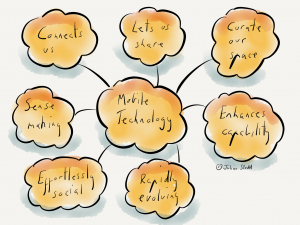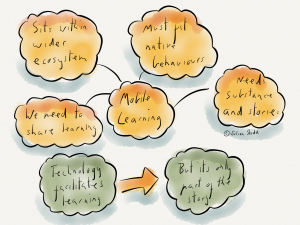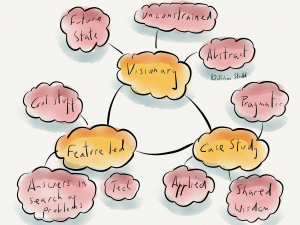#mLearnCon Reflections: The Evolution of Mobile Learning by Julian Stodd
We welcome Julian Stodd, Founder and Co-captain of SeaSalt Learning as a Guest Writer to TWIST to share his thoughts on the last week’s mLearn Conference and Expo.
 Technology, it turns out, may not save the day.
Technology, it turns out, may not save the day.
The rapid adoption of mobile technology has transformed many aspects of our lives: for instance, I no longer have to remember song names or lose at pub quizzes. It connects us with communities around the world and lets us effortlessly share everything, from photos to playlists and dentist appointments. The rise of social collaborative technology has been transformative, connecting us with knowledge and people in new and creative ways, and we’re only at the start of the journey. But we can’t view it in isolation.
Organisational uptake has been patchy at best, typified more by odd outbreaks of excellence than true transformation. The gadgets are shiny and attractive, the possibilities seemingly endless, but the creation of innovative and effective learning solutions still often lags behind the curve. More often than not, early adoption of mobile learning was to push compliance training and assessment out to people sat on the bus. It was largely about the needs of the organisation, without recognising the ways people actually wanted to learn. This is changing, but it’s a slow learning process.

I spent the last week in San Diego at mLearnCon, the eLearning Guild’s flagship mobile learning conference in San Diego. It was an opportunity to share stories, explore technology and talk to people delivering real projects in the real world, making their mistakes, innovating in new spaces, and sharing their learning.
What struck me first was the sheer bustle of the thing: not one or two sessions, but half a dozen or more concurrent presentations and workshops every hour through the three-day event. And the themes? As varied and diverse as you can imagine, from “mobile: exploring the future of learning”, through to “Assisting Transitioning Vets: a mobile performance case study”, by way of “Interactive video for training delivery”.
The breadth is healthy, the bustle refreshing: this is a time for exploration, a time to work out how the features of the technology map against our native desires and business requirements. You could see broad classes emerging: ‘visionary’ sessions, people trying to figure out what it’s all about, ‘feature’ sessions, exploring applications of specific feature sets like geolocation or augmented reality, and ‘case studies’, actual examples of application and the learning that had taken place to get them there.
Few final solutions were presented: more a collection of iterative projects and technologies in progress. Which suits me fine: this is the time for experimentation and learning. It’s the time to make your mistakes and figure out the mindset and methodology that works for you and your organisation.
The audience was often eager for solutions: how do we do this, how did you get engagement, which technologies did you use? These questions are important, but we mustn’t lose sight of the fact that mobile is just one tool in the box, it’s just one part of a much broader set of modalities we can use for learning. In its right place, applied elegantly, it’s enabling and empowering. Applied wrong, it’s clumsy and controlling. The right place to start is with outcomes: what are you trying to achieve, what are the constraints (in terms of technology, time and budget) and how will you measure those outcomes. Only once you have that straight can you truly judge whether mobile is the right path to tread.
The strong elements of curiosity, of inquiry, shone through the majority of the sessions: often the applications shown leveraged one key feature set or function and built their learning around it. For example, Brenda Enders showcased her ‘training cards’ for army medics, which used augmented reality and triggered video content to provide both abstract training and real-time emergency performance support, was a great meeting of human needs and technologically facilitated assistance. Playing card packs of ‘top trump’ like cards could be used in conjunction with a smartphone to trigger ‘how to’ videos for a range of somewhat blood spattered procedures.
You could see how the feature set of the device was being leveraged, but how did it differ from what could be done through other modalities?
I guess one key aspect of this project I liked was that it gave expanded consistency, which is always a challenge in training: the message transmitted was most certainly the message received (video does that… there’s no ambiguity or room for misinterpretation by a trainer), but it can only ever be part of a story. To be truly effective, the learning design needs to include spaces for rehearsal, time and methods for reflection and formal assessment of competence.
My own session was on ‘Creating Effective Mobile Learning in the Social Age’, and used a six stage methodology to structure overall learning design: ‘context’, which is about setting expectations and creating initial disturbance to learn, ‘demonstration’, where we illustrate core skills and behaviors, ‘exploration’, which is about playing with the learning and ‘reflection’, which is where we get learners to reflect their understanding back to us. ‘Assessment’ may be formal and tests retention and application whilst ‘footsteps’ is about transitioning back to the real world and rehearsing. Crucially, ‘mobile’ is somewhat incidental to this: we may end up using cool technology to facilitate and deliver the learning, but our focus is on the storytelling.
The medical project certainly provided the ‘demonstration’ part of it, but it’s down to other modalities and parts of the training to provide the ‘exploration’ part, the ‘reflection’ before we can look back at the app again for ‘performance support’ in the field (Brenda shared the story of how it was an almost unintended consequence that medics in the field were using the cards and App for emergency reminders of what to do, a great example of ‘footsteps’: performance support within the everyday reality of the learner). One modality, be it face to face training or eLearning, is unlikely to cover every element effectively, but effective learning requires us to run through each stage.
This is the challenge for mobile: instead of promising the earth for everything, it needs to be serving a purpose and doing that effectively, in ways that we simply can’t achieve in other modalities.
By its very nature, mobile technology sits within our pockets, so it transfers learning into the real world and out of the classroom, but that transfer comes with a responsibility to make it effective and efficient. Even as I was typing that sentence, a pop-up notification hit the top of my screen: I glanced at it and continued typing. It’s efficient, it facilitates me making decisions, even if my decision is to ignore it. Our learning solutions need to do the same: they need to fit closely to our native needs and behaviors, not try to force us into behaviors that fit their technology.
The most powerful parts of the conference for me were seeing the case studies presented and discussed: work by Robert Gadd and the teams in AutoTrader, work by Geoff Stead and his team at Qualcomm, both powerful and pragmatic illustrations of the early application of enterprise level mobile learning. Both clear what had worked and what still needed to be learned.
The least attractive elements? The rush to technology solutions always concerns me: any provider telling you they have all the answers to ‘mobile’ is probably missing the point. The early challenge was infrastructure, simply getting stuff out to people through corporate mindsets and limited bandwidth. That’s largely solved in a marketplace of solutions, any one of which can take our fancy, none of which will guarantee effective learning (just as a decade of rapid authoring tools for eLearning has largely led to a glut of poorly designed but rapidly authored eLearning modules, the success of which is measured in minutes, not application or outcomes).
 The real challenge is to learn how mobile sits within our overall blended approach, and how we can match that against the innovative feature sets on offer to us and the tools we can use to build it.
The real challenge is to learn how mobile sits within our overall blended approach, and how we can match that against the innovative feature sets on offer to us and the tools we can use to build it.
mLearnCon is one of a number of specialist events the Guild runs and there’s great value in this: the most important dynamic of the event was the collective curiosity, the collective generosity and the willingness to learn among delegates. Technology is great: later this month I’m picking up my Google Glass and i can’t wait, but what will i do with it? I have no clue whatsoever: I’m waiting for the meaning to emerge and, I hope, approaching it with an open mind. The technology will just facilitate me finding the meaning.
Similarly, the conference facilitated me finding the meaning: it provoked me, enthused me and annoyed me in equal measure, which is pretty much what success looks like. At this stage of the game, we need to iterate features, technologies and ideas. That’s how we’ll learn what really works. Then things get really fun. That’s when we come back next year to share what we’ve learned.


Leave a Reply